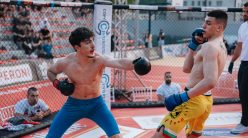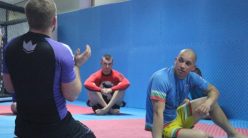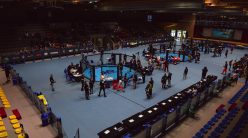You see it in a lot of students who are just beginning to spar in any striking combat sport. They are scared and aren’t sure what they are doing. When a punch or kick comes at them, they react — they flinch, cover their head, blink their eyes, and sometimes even turn their back. You can almost hear the internal dialogue, “On no. Here it comes. I’m going to get hurt.”
Free sparring is at first very uncomfortable. This type of reaction is natural – an instinctive response in an effort to defend yourself.
The result, however, is that the student is put at a momentary disadvantage since this type of reaction creates an opening an opponent can exploit. In competition the student might lose a point, but on the street this type of reaction can put him or her in real jeopardy.
If you blink you lose sight of an opponent momentarily. Vision is also disorientated during a flinch as everything becomes a blur of movement. And if you turn away, everything is exposed.
So what can you do? Actually there is a lot you can do, and answers fall into several general categories. You can retrain your reflexes, re-orient your attitude and learn how boost your visual skills.
Retraining The Reflexive Body
First you should gradually learn how to confront and deal with attacks – something that will reduce your fear and teach you how to control the natural instincts to run, flinch, blink or turn away.
One way to do this is through various drills. They go a long way to allow you to eliminate your fear in a safe environment.
DRILL 1: One of the best drills is to use a pad (often on a handle) to simulate various attacks – straight punches and hooks to the head, body shots and various types of kicks. Try to keep a proper fighting position, hands up, and move – shift position, duck under hooks, and shift your head to the side of a punch (known as slipping a punch) while blocking it with your hand or forearm. Gradually you will become more comfortable with being attacked and the pace can be increased. The pace of the practice attack should always push you a little beyond where you feel comfortable. This forces you to improve.
DRILL 2: Later, actual punches and kicks can be introduced – at first done slowly and over time increased in speed and power. While you may just be defensive at first, after a while you will learn to also take the offensive. Be careful to use protective equipment unless you are practicing this drill in slow motion.
DRILL 3: On an advanced level a similar activity entails actually allowing soft punches to land. If you are more advanced you can allow harder punches. Through this method you will learn how to take a punch, how to tighten up or move to eliminate its effects and this will reduce the fear factor by reducing perception of possible pain. Avoid any actual hits to the head, however. This is dangerous.
The Mental Switch To Offense
Most beginners focus on defense and not getting hurt. Mentally they are defensive and physically they are hesitant. They are waiting to get hit or hurt, and when anything comes near them they jump in anticipation.
Try to reorientate your thinking to one of offense, not defense. Mental focus will change from avoidance of getting hit to a focus on attack. You will begin to look for an opening and your dialogue will change too: “Good, here comes an attack I can respond to.” Fear is reduced because attention has shifted elsewhere.
Visual Reorientation
Another method to reduce flinching, blinking and turning away is to be able to re-educate how you use and control your eyes.
To reduce blinking you can control the muscles of the eyelid.

Many mistakenly try to hold their eyelids open to stop blinking, but this doesn’t work because blinking is done with the muscles that close the lids, not open them.

DRILL 4: Thus to stop or reduce the tendency to blink, slightly narrow your eyes, thus bringing conscious control over the muscles used in blinking. Have a partner punch to either side of your head, or jab toward you face but at a distance that contact won’t be made. Practice controlling your blink reaction. Keep your eyes narrowed, observing everything, but not focusing on anything.
DRILL 5: One way to help control flinching is to minimize the surprise of an opponent’s actions. Visually this can be done in two ways. At the start of sparring, or when action has momentarily ceased, look into opponents’ eyes but also perceive their whole body – at least at the beginning.
The eyes will indicate when your opponent is about to attack. So practice picking up signals from your opponents’ eyes. They provide great forewarning.
When there is action during sparring you can also use your vision to reduce the potential surprise of an opponent’s second or third technique. Do not focus on the attack itself, for if you look at it, it will fill your visual field and block your perception of what’s following. Instead you should look past any attack for what is coming next. This gives you more time to react since you will pick up attacks as they are launched, not as they are about to land. This give you time to react.
Blink Reaction Drill
A drill we use is Uppercut-Uppercut-Hook-Hook. (OK, not a very imaginative name…)
DRILL 6: Each fighter wears headgear and gloves. You crowd against one another and alternate throwing 4 punches. Fighter №1 throws two uppercuts to the body and then two hooks to the shoulders. Then fighter №2 immediately counters with the same. Each fighter defends by crowding the other fighter and blocking the hooks with elbows and “fanning” the hooks while rolling with the punches.
Even though these punches aren’t aimed at the face, this really helps people get used to taking a hit without flinching.






